なぜシステムはバロック化をとげるか?
Why do the systems become baroquenization?
Los Alamos Nuclear Facility in 1974.
なぜシステムはバロック化をとげるか?
Why do the systems become baroquenization?
Los Alamos Nuclear Facility in 1974.
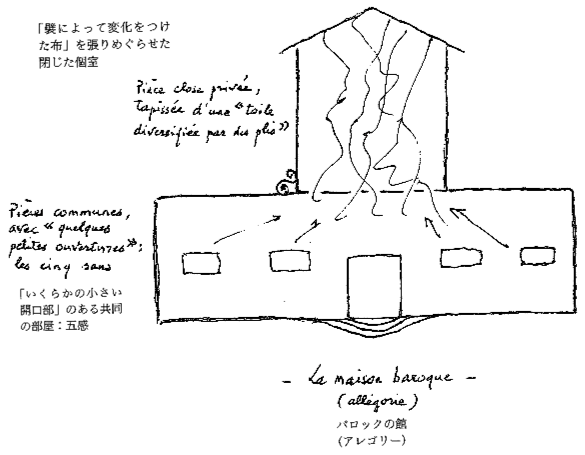 「バロックは何らかの本質にかかわるものではない。むしろ、ある操作的な機能に、線
にかかわっている。バロックはたえまなく襞を生み出すのであり、事物を作りだすので
はない。東洋からきた髪、ギリシャ的、ローマ的、ロマネスク的、ゴシック的、古典的
……といった様々な襞がある。しかしバロックは襞を折り曲げ、さらに折り曲げ、襞の
上に襞、襞にそう襞というふうに、無限に襞を増やしていくのである。バロックの線と
は、無限にいたる襞である。そして何よりもまずこの線は二つの方向にそって、二つの
無限にしたがって、襞に差異を与える。あたかも無限は、物質の折り目(replis)と、
魂の襞(pils)という、二つの階層をもつかのようである。下の階では、物質が第一の
種類の襞にしたがって集積され、ついで第二の種類にしたがって組織される。物質の部
分は「異なる仕方で折り畳まれ、いろいろな程度で展開される」器官として組織される
からである(ライプニッツ『実体の本性と実体相互の交渉ならびに心身の結合についての新たな説』著作集8)。上の階では、魂が神の栄光をうたいあげる。魂
は自分自身の襞の中をかけ
めぐるが、襞をすべて展開することはないからである。「襞には際限がないからで
ある」(『モナドロジー』第61)。一つの迷宮は、語源からしても〈多〉と呼ばれてよい。迷宮にはたくさんの襞を
もつからである。〈多〉とは、単にたくさんの部分をもつものではな
く、たくさんの仕
方で折り畳まれるもののことである。まさにおのおのの階層に、一つの迷宮が対応する。
すなわち、物質とその部分におげる連続的なものの迷宮、そして魂とその述語における
自由の迷宮である。デカルトがこれらを解明することができなかったのは、連続的なも
のの秘密を直線的な経路の中に求め、自由の秘密を魂の車線に求めるだけで、魂の勾配
にも、物質の曲線にも目をむけなかったからである。自然を数え上げ、魂を解読し、物
質の折り目の中をのぞき、魂の襞の中を読むための、一つの「暗号解読法」が必要なの
である」(ライプニッツ『結合法論』『人間知性新論』)——(ドゥルーズ『襞』宇野邦一訳、Pp.9-10、1998年)。
「バロックは何らかの本質にかかわるものではない。むしろ、ある操作的な機能に、線
にかかわっている。バロックはたえまなく襞を生み出すのであり、事物を作りだすので
はない。東洋からきた髪、ギリシャ的、ローマ的、ロマネスク的、ゴシック的、古典的
……といった様々な襞がある。しかしバロックは襞を折り曲げ、さらに折り曲げ、襞の
上に襞、襞にそう襞というふうに、無限に襞を増やしていくのである。バロックの線と
は、無限にいたる襞である。そして何よりもまずこの線は二つの方向にそって、二つの
無限にしたがって、襞に差異を与える。あたかも無限は、物質の折り目(replis)と、
魂の襞(pils)という、二つの階層をもつかのようである。下の階では、物質が第一の
種類の襞にしたがって集積され、ついで第二の種類にしたがって組織される。物質の部
分は「異なる仕方で折り畳まれ、いろいろな程度で展開される」器官として組織される
からである(ライプニッツ『実体の本性と実体相互の交渉ならびに心身の結合についての新たな説』著作集8)。上の階では、魂が神の栄光をうたいあげる。魂
は自分自身の襞の中をかけ
めぐるが、襞をすべて展開することはないからである。「襞には際限がないからで
ある」(『モナドロジー』第61)。一つの迷宮は、語源からしても〈多〉と呼ばれてよい。迷宮にはたくさんの襞を
もつからである。〈多〉とは、単にたくさんの部分をもつものではな
く、たくさんの仕
方で折り畳まれるもののことである。まさにおのおのの階層に、一つの迷宮が対応する。
すなわち、物質とその部分におげる連続的なものの迷宮、そして魂とその述語における
自由の迷宮である。デカルトがこれらを解明することができなかったのは、連続的なも
のの秘密を直線的な経路の中に求め、自由の秘密を魂の車線に求めるだけで、魂の勾配
にも、物質の曲線にも目をむけなかったからである。自然を数え上げ、魂を解読し、物
質の折り目の中をのぞき、魂の襞の中を読むための、一つの「暗号解読法」が必要なの
である」(ライプニッツ『結合法論』『人間知性新論』)——(ドゥルーズ『襞』宇野邦一訳、Pp.9-10、1998年)。
"And compounds are in
this respect analogous with [symbolisent avec] simple substances. For
all is a plenum (and thus all matter is connected together) and in the
plenum every motion has an effect upon distant bodies in proportion to
their distance, so that each body not only is affected by those which
are in contact with it and in some way feels the effect of everything
that happens to them, but also is mediately affected by bodies
adjoining those with which it itself is in immediate contact. Wherefore
it follows that this inter-communication of things extends to any
distance, however great. And consequently every body feels the effect
of all that takes place in the universe, so that he who sees all might
read in each what is happening everywhere, and even what has happened
or shall happen, observing in the present that which is far off as well
in time as in place: σύµπνοια πάντα, as Hippocrates said. But a soul
can read in itself only that which is there represented distinctly; it
cannot all at once unroll everything that is enfolded in it, for its
complexity is infinite. " - Gottfried Wilhelm LEIBNIZ, The
Monadology. #61
「そして、この点において、化合物は単純物質と類似している。なぜなら、すべてはプルーン
(完全体)であり(したがって、すべての物質は互いに結びついている)、プルーンにおいては、あらゆる運動は、その距離に比例して、遠く離れた物体に影響
を及ぼす。そのため、各物体は、それと接触している物体の影響を受けるだけでなく、それらに起こるあらゆる出来事の影響を何らかの形で感じる。また、それ
自体が直接接触している物体に隣接する物体によっても、間接的に影響を受ける。したがって、この事物間の相互通信は、どんなに遠く離れていても及ぶことに
なる。そして、その結果、あらゆる物体は宇宙で起こるすべての出来事の影響を感じる。そのため、すべてを見通す者は、それぞれの場所で起こっていることを
読み取ることができる。また、過去に起こったことやこれから起こることも読み取ることができる。ヒポクラテスの言葉によれば、σύµπνοια
πάντα(すべては共犯者)である。しかし、魂は、そこに明確に表現されているものだけを自分自身で読み取ることができる。魂は、その中に折りたたまれ
ているものをすべて一度に広げることはできない。なぜなら、その複雑性は無限だからだ。」
軍事技術のバロック化 とは、バロック芸術(Arte barocca)のように、軍事技術は、その当時のイノ ベーション(そのものよりも思想)を受け入れて、次々と「効用」以上の肥大化を遂げてしまうこと、をさす。第二次大戦中の戦艦大和(Japanese battleship Yamato, Aug.08, 1940-Dec. 14, 1945)の建造などは、そのバロック化の際たるものである。
The
baroquenization of military technology refers to the fact that, like
baroque art (Arte barocca), military technology embraces the
innovations of the time (ideas rather than the technology itself) and
successively expands beyond its "utility."
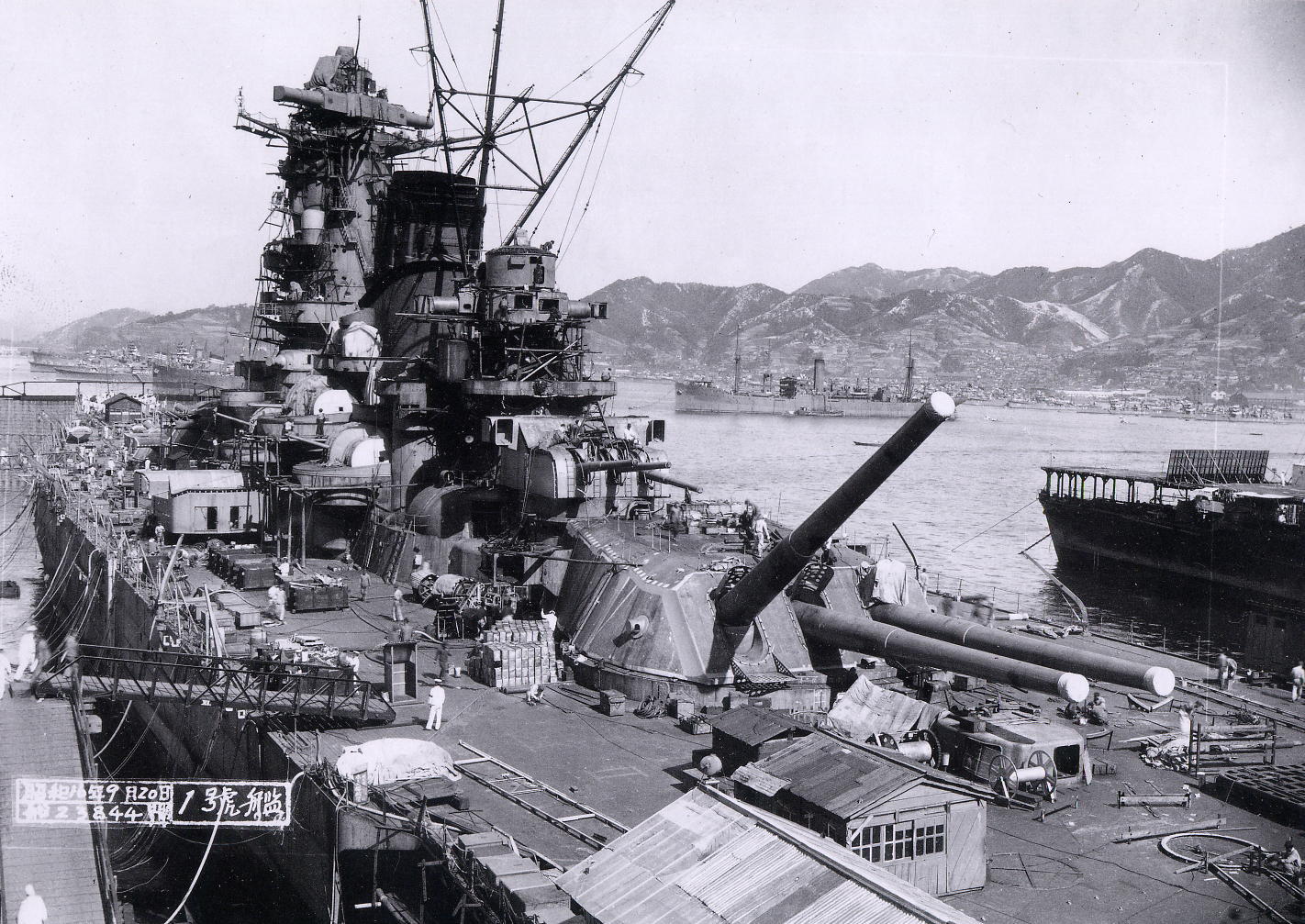

Yamato near the end of her fitting out, 20
September 1941 at Kure Naval Base, Japan. Interno della chiesa del Gesù, Roma (la volta
è del Baciccio)
バロックという用語と概念を一番最初に軍備に関して 導入し たのは、ハーバート・ヨーク(Herbert Frank York, 1921-2009)という核物理学者である。彼は元・リバモア放射線研究所(Lawrence Livermore National Laboratory)の所長で、政府高官も務めたことがある(カルドー 1986:9)。
ヨークの略歴にはこうある。
" After leaving the laboratory in 1958, he held numerous positions in both government and academia, including the first Chief Scientist of the Advanced Research Projects Agency, and the first Director of Defense Research and Engineering.York was a professor of physics at the University of California, Berkeley. He was the founding Chancellor of the University of California, San Diego (1961–1964, 1970–1972). He later served as U.S. ambassador to the Comprehensive Test Ban negotiations in Geneva, Switzerland (1979–1981). York was Director Emeritus of the Institute on Global Conflict and Cooperation at UC San Diego and served as chairman of the university's Scientific and Academic Advisory Committee, which oversees activities at both Livermore and Los Alamos National Laboratories. He also served on the board of the Council for a Livable World, a nonpartisan arms control organization in Washington, D.C. York occasionally guest lectured for UC San Diego and other institutions" - Herbert Frank York, 1921-2009
「1958年に研究所を去った後、彼は政府および学
術機関の両方で数多くの役職を歴任し、その中には、国防高等研究計画局(ARPA)の初代チーフ・サイエンティスト、および国防研究・工学局の初代局長も
含まれている。ヨークはカリフォルニア大学バークレー校の物理学教授でもあった。カリフォルニア大学サンディエゴ校の初代学長(1961年~1964年、
1970年~1972年)を務めた。その後、スイス・ジュネーブでの包括的核実験禁止条約(CTBT)交渉における米国大使(1979年~1981年)を
務めた。ヨークはカリフォルニア大学サンディエゴ校のグローバル・コンフリクト・アンド・コーポレーション研究所の名誉所長であり、リバモア国立研究所と
ロスアラモス国立研究所の両方の活動を監督する同大学の科学・学術諮問委員会の委員長も務めた。また、ワシントンD.C.の超党派軍備管理組織である「住
みよい世界協議会」の理事も務めた。ヨークはカリフォルニア大学サンディエゴ校やその他の教育機関で、時折ゲスト講師として講義を行っていた」。
バロック化する要素は、シ ステムそのものの自己目的化、自己増殖肥大化、内向的完成(の自己目的)化な どによることが指摘されている。
このバロック化を核戦争の武器開発のみならず、兵器 一般の開発競争に敷衍したのが、メアリ・カルドー(Mary Kaldor, 1946- )のいう「バロック的兵器廠」(1981)である。
カルドーのアイディアも、やはり核兵器の開発戦争 の、インヴォルーション(内旋化)の現象から来ていることは、彼女のこの書物が書かれた彼女のアカデミックキャリアーから推察できる。
"Before the LSE, Kaldor worked at the Stockholm International Peace Research Institute (SIPRI) and now serves on its governing board.[4] She also worked at the Science Policy Research Unit at the University of Sussex,[5] where she worked closely with the English economist Christopher Freeman. She was a founding member of European Nuclear Disarmament, editing its European Nuclear Disarmament Journal (1983–88). She was the founder and Co-Chair of the Helsinki Citizens Assembly,[5] and a founding member of the European Council on Foreign Relations" - Mary Kaldor, 1946-
「LSE以前は、ストックホルム国際平和研究所
(SIPRI)に勤務し、現在は同研究所の理事会のメンバーを務めている。[4] また、サセックス大学の科学政策研究ユニットにも勤務し、[5]
そこで英国の経済学者クリストファー・フリーマンと緊密に協力した。彼女は欧州核軍縮(European Nuclear
Disarmament)の創設メンバーであり、その機関誌『欧州核軍縮ジャーナル』(European Nuclear Disarmament
Journal)の編集にも携わった(1983年~1988年)。また、ヘルシンキ市民会議(Helsinki Citizens
Assembly)の創設者および共同議長であり、欧州外交評議会の創設メンバーでもある」。
●イノベーションが起きてバロック化が終焉するケー ス
ドナルド・ノーマン『インビジブル・コンピュータ』 (邦訳260ページ)に飛行機のコックピットは、さまざまな計器がどんどん付加される傾向にあったのが、ビデオモニターの登場で少なくなっていったという アピソードが紹介されている。計器が複雑さを極めたのがコンコルド(Concorde, 1969-2003)だという。
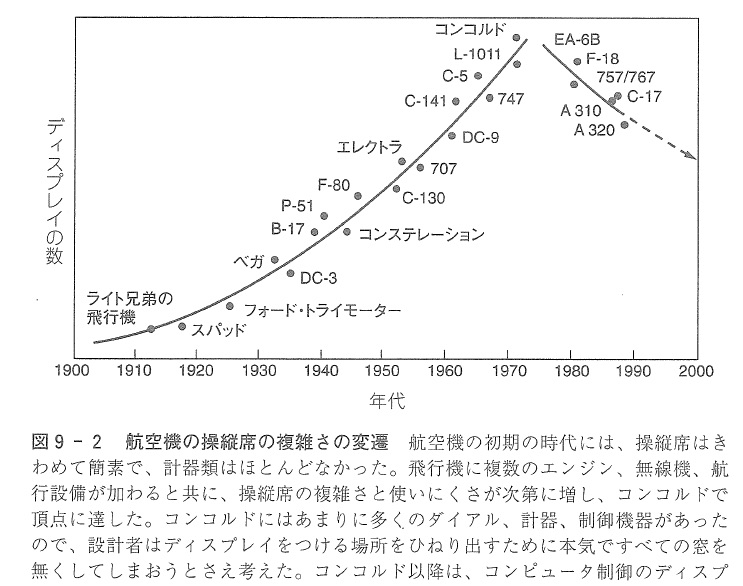
左)コンコルド;右)ボーイング777(Boeing 777)
●戦争の技術論(「大 艦巨砲主義」を事例に)
「大艦巨砲主義(たいかんきょほうしゅぎ)とは、艦
隊決戦による敵艦隊撃滅のため大口径の主砲を搭載し重装甲の艦体を持つ戦艦を中心とする
艦隊を指向する海軍軍戦備・建艦政策および戦略思想[1]。巨砲大艦主義、巨艦巨砲主義、巨砲巨艦主義、大艦大砲主義とも言う。
英国海軍戦艦ドレッドノート
(1906年)が各国間の建艦競争を大艦巨砲主義に走らせる契機となった[2]。しかし、タラント空襲や真珠湾攻撃、マレー沖海戦の戦訓により、適切な航
空援護なしに戦艦を戦闘に参加させてはならないことが認識された[3]。19世紀末ごろから主に蒸気機関の発達によって、大型で高速の艦艇が作れるように
なった。
同時に艦砲は大型化するほど射程も伸び、威力も大きくなる。そこで、大型の軍艦に大型の砲をより多く搭載しようという考え方が大艦巨砲主義であり、19世
紀末から20世紀前半まで主要海軍国で支持されていた[4]。
日本海軍でも、日露戦争時の日本海海戦で大艦巨砲と「艦隊決戦」を至上とする考え方が確立された(海
戦要務令)。その後も太平洋戦争後半期まで軍令・戦術上の主流となった。長駆侵攻してくる敵艦隊を全力で迎撃・撃退するのが基本方針であり、その
際の主役は戦艦とされ、航空母艦・巡洋艦・駆逐艦などは脇役に過ぎないという思想があった。[要出典]
大艦巨砲主義の進展は、方位盤をはじめとする射撃管制装置の発達とも関連し
ている。射程の長い砲があっても、遠距離で敵艦に命中させられる技術がなければ無意味だからである。
「ドレッドノート」が画期的だったのは、多数の主砲の射撃管制を可能とする射法の完成あってのことである。1940年頃まで各国の戦艦は光学式測距儀と方
位盤射撃を用いた射撃管制装置を主用していた。しかし米英では1941年以降レーダーの実用化により、着弾観測については光学式測距儀よりもレーダーを使
用した電測射撃に移行していった。これに対し、日独は米英に電子兵装で格段に後れを取り、電測測距と併用したものの、光学式測距儀を最後まで実戦で主用し
た。なお、フランスはすぐに敗戦したため、射撃用レーダーを搭載したもののその効果は不明である。イタリアは終戦時まで対空見張り用レーダーのみだった。
光学式の測距はとくに遠距離射撃では誤差が大きく、近距離でも夜間、曇天、悪天候などで視界の悪い時にレーダー管制に劣っていた。そのため、水上艦艇同士
の戦闘において電測射撃が行えることはかなり優位だった。ただ、初期の射撃用レーダーは測距性能は充実していたものの方位探知角が不足しており、時には光
学観測射撃に後れを取ることもあった。[要出典]。他国より大型の戦艦に巨大な主砲を搭載するという、文字どおりの大艦巨砲主義は1936年のワシントン
海軍軍縮条約明け後には終焉を迎え、 前代と同程度、あるいはやや小型化した主砲の採用例が多くなった。
第一次世界大戦中の1916年に生起したユトランド沖海戦において、イギリスとドイツが弩級戦艦・超弩級戦艦を含む艦隊で衝突し、長距離砲撃戦の重要性が
再認識されたことで各国の大艦巨砲主義は一層強まり[5]、速力と防御力の向上を追求したポスト・ジュットランド艦(高速戦艦)が建造されたが、必然的に
排水量も増えてしまい主砲口径の増大を諦めざるを得なかった為である。
この反省から、速力・防御力のバランスが戦艦の設計で重要視されるようになった。これまでの戦艦は速度を、巡洋戦艦は防御力を妥協して排水量を抑えていた
が、そのような設計の問題点が明らかになった。
そして、航空機の発達により第二次世界大戦中に航空機の優位が確立、航空主兵論の台頭が戦艦時代の終わりを告げることとなった。
アメリカで計画されていた、大和型戦艦(72,800t 45口径46cm 9門)と同等のモンタナ級戦艦(71,922t 50口径16インチ砲
12門)全5隻が1943年に建造中止されたことをもって戦艦は終焉を迎えた。
その後竣工したアイオワ級戦艦やヴァンガードやジャン・バールなどはそれ以前に起工したものであり、以後戦艦の新造は行われていない」大艦巨砲主義)→「戦争
の文化人類学的研究」より)。
★バロック化のグローバリゼーション
| Military
globalization is defined by David Held as "the process which embodies
the growing extensity and intensity of military relations among the
political units of the world-system. Understood as such, it reflects
both the expanding network of worldwide military ties and relations, as
well as the impact of key military technological innovations (from
steamships to satellites), which over time, have reconstituted the
world into a single geostrategic space".[1] For Robert Keohane and
Joseph Nye, military globalization entails 'long-distance networks of
interdependence in which force, and the threat or promise of force, are
employed".[2] Held divides the military globalization into three distinct phenomena: 1. The globalization of the war system. This refers to the "geopolitical order, great power rivalry, conflict and security relations". 2. The global system of arms production and transfers, reflected in the global arms dynamics. 3. The geo-governance of violence, "embracing the formal and informal international regulation of the acquisition, deployment and use of military force".[3] All three processes above "are connected to technological development, which made them possible in the first place. The result is increasing global interdependence and complexity".[4] The process of military globalization starts with the Age of Discovery, when the European colonial empires began military operations on the global scale. Their "imperial rivalry led to the First World War, which was the first global conflict in world history".[5][6] Keohane dates military globalization at least from the time of the conquests of Alexander the Great.[7] |
デビッド・ヘルドは、軍事のグローバル化を「世界システムにおける政治
単位間の軍事関係の拡大と深化を体現するプロセス」と定義している。このように理解すると、世界的な軍事関係の拡大と深化の両方を反映していることがわか
る。また、蒸気船から衛星に至るまでの主要な軍事技術革新が、時間をかけて世界を単一の地政学的空間へと再構成してきた影響も反映している。[1]
ロバート・ケオハーンとジョセフ・ナイは、軍事のグローバル化とは「武力、および武力の脅威や可能性が行使される長距離の相互依存ネットワーク」を意味す
ると述べている。[2] ヘルトは軍事のグローバル化を3つの異なる現象に分類している。 1.戦争システムのグローバル化。これは「地政学的秩序、大国間の競争、紛争、安全保障関係」を指す。 2.武器生産と移転のグローバルシステム。これは世界的な武器の力学に反映されている。 3. 「軍事力の獲得、展開、使用に関する公式および非公式の国際的規制」を含む、暴力の地理的統治。[3] 上記の3つのプロセスはすべて、「技術開発と関連しており、それがまず第一にこれらのプロセスを可能にした。その結果、世界的な相互依存と複雑さが増して いる」[4]。 軍事のグローバル化のプロセスは、ヨーロッパの植民地帝国が世界規模での軍事行動を開始した大航海時代に始まる。彼らの「帝国間の競争は第一次世界大戦に つながり、それは世界史上初のグローバルな紛争であった」[5][6]。キオハネは、軍事のグローバル化は少なくともアレクサンダー大王による征服の時代 から始まったと述べている。[7] |
| International relations World government World war World War III Criticisms of globalization |
国際関係 世界政府 世界大戦 第三次世界大戦 グローバリゼーションへの批判 |
| https://en.wikipedia.org/wiki/Military_globalization |
|
World War III
as a consequence of the “baroquenization” of war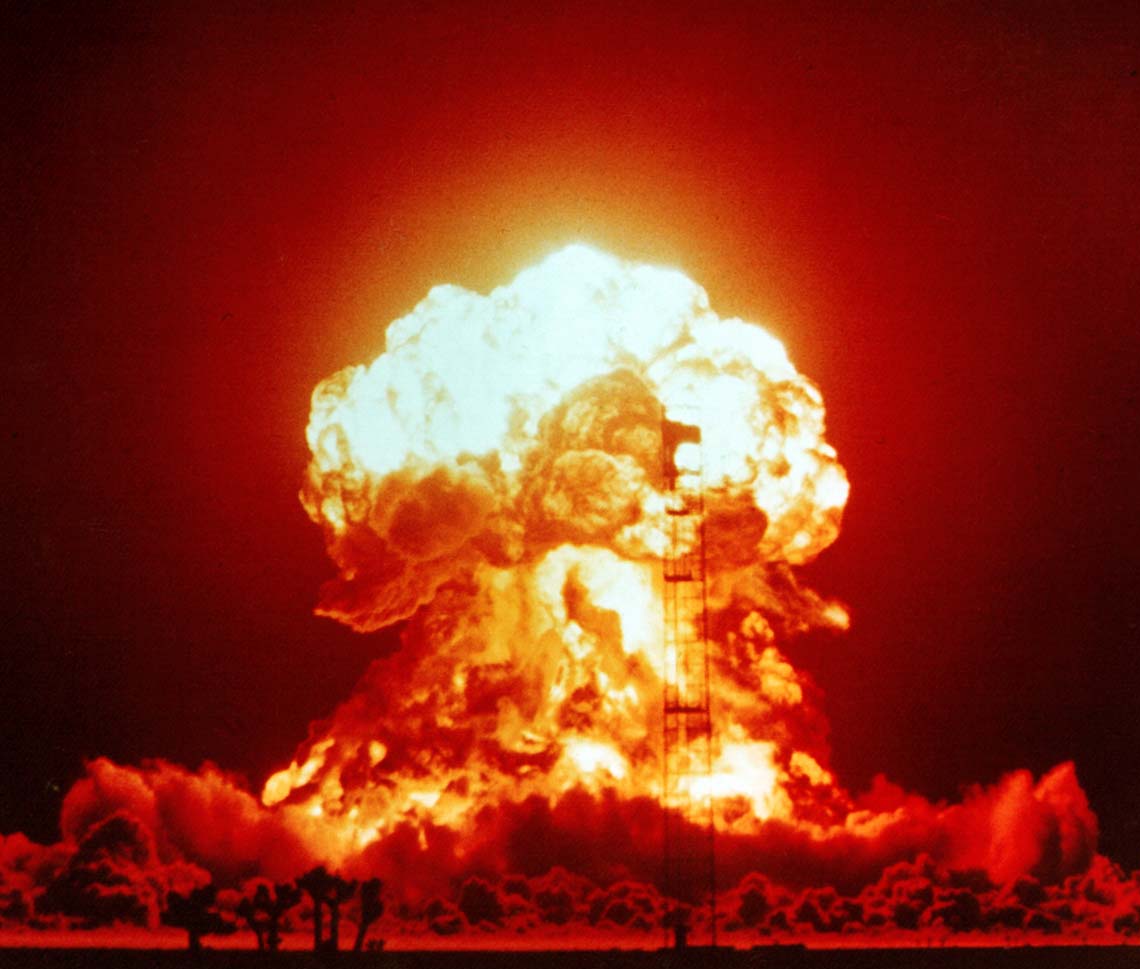 "I know not with what weapons World War III will be fought, but World War IV will be fought with sticks and stones" - Albert Einstein In 1949, after the unleashing of nuclear weaponry at the end of World War II, physicist Albert Einstein suggested that any outcome of a possible World War III would be so dire as to revert mankind to the Stone Age. When asked by journalist Alfred Werner what types of weapons Einstein believed World War III might be fought with, Einstein warned, "I know not with what weapons World War III will be fought, but World War IV will be fought with sticks and stones".[102][103] As for the extermination of the human race as a consequence of atomic war, Leslie A. White challenged Einstein, "this too may be admitted as possibility, and all we can say is that if it is to come, it will come. Extravagant expressions of horror will not alter the course of events."[104] Crane Brinton also doubted the psychological pacification of Einstein: "Teachers, preachers, educators, even politicians are telling the growing generation that there must be no war and, therefore, there will be no war. I have doubts as to whether this is wise teaching…" In spite of the atomic bomb, there will be another general war and humanity will survive it.[105] James Burnham of the Office of Strategic Services (the precursor to the CIA), also believed in survival: The uniqueness of the atomic weapons is commonly found in that they can totally annihilate human life, including through climatic and geological chain reaction, but such is not the case. The great principles of military strategy stand unaltered. An atomic war will look different from older wars but it will be decided by the same combination of resources, morale and strategy.[106] A 1998 New England Journal of Medicine overview found that "Although many people believe that the threat of a nuclear attack largely disappeared with the end of the Cold War, there is considerable evidence to the contrary".[107] In particular, the United States–Russia mutual detargeting agreement in 1994 was largely symbolic and did not change the amount of time required to launch an attack. The most likely "accidental-attack" scenario was believed to be a retaliatory launch due to a false warning, similar to the 1983 incident.[107] Historically, World War I happened through an escalating crisis; World War II happened through deliberate action. Hypothesized flashpoints in the 2010s and the 2020s include the Russian invasion of Ukraine, Chinese expansion into adjacent islands and seas,[1] Sino-Indian border dispute, Chinese threats of military operation against Taiwan, Indo-Pakistani wars border conflicts, and foreign involvement in the Syrian civil war. Other hypothesized risks are that a war involving or between Saudi Arabia and Iran, Israel and Iran, United States and Iran, India and Pakistan, Ukraine and Russia, Poland and Belarus, South Korea and North Korea, or Taiwan and China could escalate via alliances or intervention into a war between "great powers" such as the United States, United Kingdom, France, Germany, Russia, China, India, Japan or an all out war between military alliances NATO and CSTO, or even the possibility of a "rogue commander" under any nuclear power might launch an unauthorized strike that escalates into a full-blown war.[108] According to a peer-reviewed study published in the journal Nature Food in August 2022, a full-scale nuclear war between the United States and Russia, releasing over 150 Tg of stratospheric soot, could indirectly kill more than five billion people by starvation during a nuclear winter. More than two billion people could die of starvation from a smaller-scale (5–47 Tg) nuclear war between India and Pakistan.[109][110] In the event of a nuclear war between Russia and the United States, 99% of the population in the belligerent countries, as well as Europe and China, would die.[111] Some scenarios involve risks due to upcoming changes from the known status quo. In the 1980s the Strategic Defense Initiative made an effort at nullifying the USSR's nuclear arsenal; some analysts believe the initiative was "destabilizing".[112][113] In his book Destined for War, Graham Allison views the global rivalry between the established power, the US, and the rising power, China, as an example of the Thucydides Trap. Allison states that historically, "12 of 16 past cases where a rising power has confronted a ruling power" have led to fighting.[114] In 2020 and 2023, the Bulletin of the Atomic Scientists advanced its Doomsday Clock, citing among other factors a predicted destabilizing effect from upcoming hypersonic weapons.[115] Emerging technologies, such as artificial intelligence, could hypothetically generate risk in the decades ahead. A 2018 RAND Corporation report has argued that AI and associated information technology "will have a large effect on nuclear-security issues in the next quarter century". A hypothetical future AI could provide a destabilizing ability to track "second-launch" launchers. Incorporating AI into decision support systems used to decide whether to launch, could also generate new risks, including the risk of an adversarial exploitation of such an AI's algorithms by a third party to trigger a launch recommendation.[116][117] A perception that some sort of emerging technology would lead to "world domination" might also be destabilizing, for example by leading to fear of a pre-emptive strike.[118] Cyber warfare is the exploitation of technology by a nation-state or international organization to attack and destroy the opposing nation's information networks and computers. The damage can be caused by computer viruses or denial-of-service attacks (DoS). Cyberattacks are becoming increasingly common, threatening cybersecurity and making it a global priority.[119][120] There has been a proliferation of state-sponsored attacks. The trends of these attacks suggest the potential of a cyber World War III.[120] The world's leading militaries are developing cyber strategies, including ways to alter the enemy's command and control systems, early warning systems, logistics, and transportation.[120] The 2022 Russian invasion of Ukraine has sparked concerns about a large-scale cyberattack, with Russia having previously launched cyberattacks to compromise organizations across Ukraine. Nearly 40 discrete attacks were launched by Russia which permanently destroyed files in hundreds of systems across dozens of organizations, with 40% aimed at critical infrastructure sectors in Ukraine.[121] Russia's use of cyberwarfare has turned the war into a large-scale "hybrid" war in Ukraine.[121] |
《戦争のバロック化の帰結としての第三次世界大戦》 「第3次世界大戦がどのような武器で戦われるかは知らないが、第4次世界大戦は棒と石で戦われるだろう」 - アルバート・アインシュタイン 1949 年、第二次世界大戦の終結時に核兵器が使用されたことを受け、物理学者アルバート・アインシュタインは、第三次世界大戦が勃発した場合、その結末は人類を 石器時代に逆戻りさせるほど悲惨なものになるだろうと示唆した。ジャーナリストのアルフレッド・ワーナーに、アインシュタインが第三次世界大戦で使用され る可能性のある兵器の種類について尋ねられた際、アインシュタインは「第三次世界大戦がどのような兵器で戦われるかは知らないが、第四次世界大戦は棒や石 で戦われるだろう」と警告した。[102][ 103] 原子戦争の結果として人類が絶滅することについて、レスリー・A・ホワイトはアインシュタインにこう挑んだ。「それも可能性として認めざるを得ない。我々 に言えることは、もしそれが起こるのであれば、それは起こるだろうということだけだ。大げさに恐怖を表現しても、事態の推移を変えることはできない」 [104] クレーン・ブリントンもまた、アインシュタインの心理的平定を疑っていた。「教師、説教師、教育者、さらには政治家までもが、成長する世代に対して、戦争 はあってはならないことだと説いている。これが賢明な教えであるかどうか、私は疑問に思う…」 原爆があろうとも、また総力戦が起こり、人類は生き残るだろう。[105] 戦略事務局(CIAの前身)のジェームズ・バーナムもまた、人類は生き残ると信じていた。原子兵器の唯一無二の特徴は、気候や地質学的な連鎖反応も含め、 人類の生命を完全に消滅させることができることだが、そうはならない。軍事戦略の偉大な原則は不変である。原子力戦争は、従来の戦争とは異なる様相を呈す るだろうが、その勝敗は、従来と同じく、資源、士気、戦略の組み合わせによって決まるだろう。 1998年の『ニューイングランド・ジャーナル・オブ・メディシン』誌の概説によると、「多くの人々は、核攻撃の脅威は冷戦の終結とともにほぼ消滅したと 考えているが 、それとは反対の証拠が数多く存在する」と結論づけている。[107] 特に、1994年の米ロ相互デタ―ゲティング協定は、ほとんど象徴的なものであり、攻撃開始に必要な時間を変えるものではなかった。最も起こりそうな「偶 発的攻撃」のシナリオは、1983年の事件と同様に誤報による報復攻撃であると考えられていた。[107] 歴史的に見ると、第一次世界大戦は危機のエスカレートによって引き起こされ、第二次世界大戦は意図的な行動によって引き起こされた。2010年代および 2020年代における想定される火種としては、ロシアによるウクライナ侵攻、中国の近隣諸島および近隣海域への進出[1]、中印国境紛争、台湾に対する中 国の軍事作戦の脅威、印パ戦争の国境紛争、シリア内戦への外国の介入などが挙げられる。その他の想定されるリスクとしては、サウジアラビアとイラン、イス ラエルとイラン、米国とイラン、インドとパキスタン、ウクライナとロシア、ポーランドとベラルーシ、韓国と北朝鮮、台湾と中国が関与する、あるいはこれら の国々同士の戦争が、同盟関係や介入を通じて、米国、英国、フランス、ドイツ、ロシア、中国、インド、日本などの「大国」間の戦争、あるいは軍事同盟であ るNATOとCSTO間の全面戦争へとエスカレートする可能性がある。あるいは、核保有国の「ならず者司令官」が、承認されていない攻撃を開始し、本格的 な戦争にエスカレートする可能性さえある。[108] 2022年8月に学術誌『Nature Food』に掲載された査読済みの研究によると、米国とロシアの間で全面的な核戦争が起こり、150テラグラム以上の成層圏ススが放出されると、核の冬の 間に飢餓によって50億人以上が間接的に死亡する可能性がある。インドとパキスタン間のより小規模な(5~47 Tg)核戦争でも、20億人以上が飢餓によって死亡する可能性がある。[109][110] ロシアと米国の核戦争の場合、交戦国である両国の人口の99%が死亡し、ヨーロッパと中国にも被害が及ぶ。[111] 一部のシナリオでは、既知の現状からの変化に伴うリスクが含まれている。1980年代には戦略防衛構想(SDI)がソビエト連邦の核兵器を無効化しようと したが、一部のアナリストは、この構想が「不安定化」をもたらしたと考えている。[112][113] グレアム・アリソンは著書『戦争への宿命』の中で、既存の大国である米国と新興国である中国の間の世界的な対立を、トゥキディデスの罠の例として捉えてい る。アリソンは、歴史的に「台頭する勢力が支配勢力と対峙した過去の16件のうち12件」が戦闘に至ったと述べている。[114] 2020年と2023年には、原子力科学者会報が終末時計を早めたが、その理由として、今後登場する極超音速兵器による不安定化効果を予測する要因を挙げ ている。[115] 人工知能などの新技術は、仮説上、今後数十年にわたってリスクを生み出す可能性がある。2018年のランド研究所の報告書は、AIと関連する情報技術が 「今後四半世紀の核セキュリティ問題に大きな影響を与える」と主張している。仮説上の未来のAIは、「2度目の発射」を行う発射機を追跡する不安定化能力 を提供できる可能性がある。発射の是非を決定する際に使用される意思決定支援システムにAIを組み込むことは、第三者がAIのアルゴリズムを悪用して発射 勧告を発動させるという新たなリスクを生み出す可能性もある。[116][117] 新たな技術が「世界支配」につながるという認識は、例えば先制攻撃への恐怖につながることで不安定化する可能性もある。[118] サイバー戦争とは、国家または国際組織が技術を悪用して、敵対する国家の情報ネットワークやコンピュータを攻撃し破壊することである。被害はコンピュータ ウイルスやサービス拒否攻撃(DoS)によって引き起こされる。サイバー攻撃はますます一般的になっており、サイバーセキュリティを脅かし、世界的な優先 事項となっている。国家が支援する攻撃が増加している。これらの攻撃の傾向は、サイバー第三次世界大戦の可能性を示唆している。[120] 世界の主要な軍隊は、敵の指揮統制システム、早期警戒システム、兵站、輸送手段を変更する方法を含むサイバー戦略を開発している。[120] 2022年のロシアによるウクライナ侵攻は、大規模なサイバー攻撃に対する懸念を呼び起こした。ロシアは以前にも、ウクライナ全土の組織を危険にさらすサ イバー攻撃を仕掛けていた。ロシアによる40件近い攻撃により、数十の組織にわたる数百のシステムのファイルが恒久的に破壊され、そのうち40%はウクラ イナの重要インフラ部門を標的としたものだった。[121] ロシアによるサイバー戦争の使用により、ウクライナでは戦争が大規模な「ハイブリッド」戦争へと変貌した。[121] |
| https://en.wikipedia.org/wiki/World_War_III |
リンク
文献
その他の情報
Do not copy and paste, but you might [re]think this message for all undergraduate students!!!
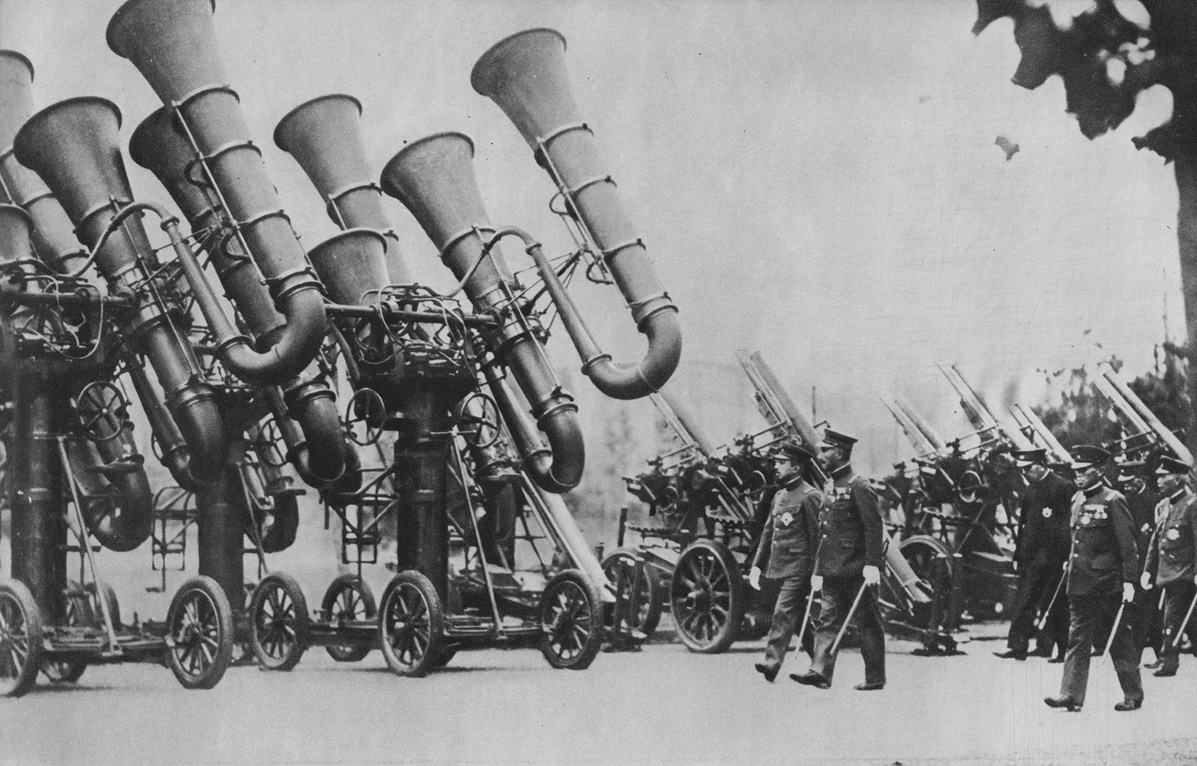


++
☆
 ☆
☆